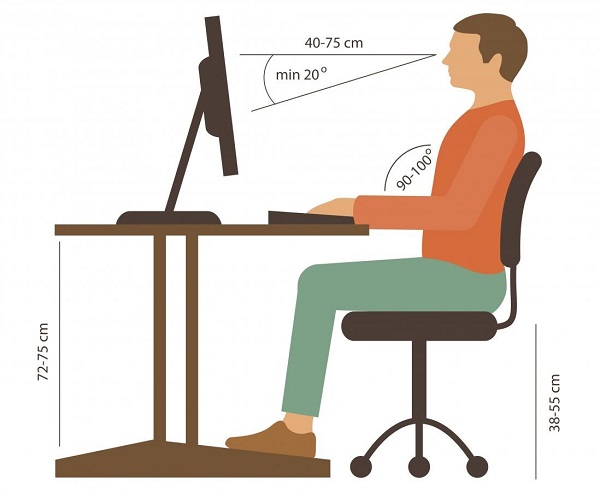Are you working in an office environment, sitting at a desk for the majority of the day? Worryingly, the average office worker spends around 10 hours sitting down, if you include the daily commute as well as any after hours activities (or lack of them).
Recent medical research warns that the long-term consequences of sitting or lying down for large periods of the day are linked to around 70,000 deaths in the UK per year, costing the NHS £700 million. Sedentary lifestyles can increase the risk of heart disease, type 2 diabetes and cancer.
In the short term, too much sitting puts extra stress on your spine and vertebral discs as well as the muscles and ligaments in the lumbar (lower back) region. If you suffer from neck, shoulder or back pain, these are often the first physical signs that something is wrong. Add to that any bad posture habits that many of us have acquired without even realising, and you may well be headed for health and mobility problems in the longer term.
Assuming that you are committed to an office-based career, it is clear that you need to take action now in order to avoid the potential health outcomes mentioned above. Maintaining a good posture while you’re seated at your desk is key, so let’s start with what you can do about sitting properly to minimise any damage to your back.
1. Get the right office chair for your needs
As far as your back is concerned, your office chair is the single most important piece of office equipment. Review your current chair to see if it is fit for purpose. Speak to your manager about carrying out a workstation assessment and investing in a professional, ergonomically designed chair that is suitable for all-day sitting. The chair should be comfortable to sit on, height adjustable and offer good lumbar support. Any good office furniture supplier should be able to let you try out a chair for a few days before you commit to purchasing.
2. Get into the habit of sitting properly
Once you have the right chair, you must spend some time adjusting the height, back and tilt positions to give you optimum support and comfort. Sit down with a straight upper back and press your hips against the back for the chair. Is the natural curvature of your lower back adequately supported by the chair’s lumbar support? Your knees should be slightly lower that your hips, with your feet flat on the floor. Here’s a handy 5-point checklist, courtesy of leading back pain expert Peter Blenkarn, Nimbus Clinics:
- Keep both feet on the floor or footrest.
- Ankles should be in front or level with the knees, and the knees at/below hip height.
- Maintain a small gap between the back of your knees and the edge of your seat.
- In chairs with a backrest, use it to support your low and mid back, adding a back support if needed.
- Relax your shoulder and draw your shoulder blades together slightly, sitting straight up. Do not hunch your back.
Finally, don’t be tempted to cross your legs when sitting at a desk (or anywhere, for that matter). This position is considered to be an awkward ergonomic posture which can lead to discomfort, injury and posture problems over time.
3. Position your arms correctly
Next, pay attention to your arms. In the correct seated position (as instructed above), move your chair towards the desk until your keyboard and mouse are within easy reach. The keyboard should be about 10-15 cm away from the edge of the desk, so that you can rest your wrists on the table or a wrist pad. Observe and adjust your body position carefully. Having to routinely reach too far forward can lead to tension build-up in your back muscles over time. Your wrists and arms should be parallel to the floor. If necessary, adjust your armrest so that your arms are slightly lifted at the shoulders and to alleviate any upper back strain and stop you from slouching.
4. Position your computer screen at the right height
Finally, check the position of your computer monitor. It should be set up to allow you to look straight at the top edge of the screen, about an arm’s distance away from you. If the screen is positioned too low, the continuous looking down will strain your neck muscles, leading to neck pain after just a few hours’ work. Most modern desktop computer monitors are height adjustable so this shouldn’t happen. But if your screen cannot be moved up or down, you may need to add a mount, stand or shelf underneath to give you the optimum solution.
5. How to improve the ergonomics of a laptop
People who work with laptops, either at an office desk or elsewhere, can find it particularly difficult to maintain a good posture. Since there is a fixed ratio between the screen and the keyboard, the ideal ergonomic positioning as mentioned above, is simply impossible to achieve. Either the screen is too low or the keyboard too high – it’s a lose lose situation. Laptops were originally designed for travelling, and not with ergonomics in mind, so you will have to correct the situation with the help of an additional monitor or keyboard, as shown below.
6. Take regular breaks away from the desk
Even with the best office chair in the world and the perfect ergonomic set-up at your disposal, it is essential that you get up and move around are regular intervals. Taking a break every 30-60 minutes is a good yardstick to provide enough concentration time to get a task done, then giving your muscles a chance to relax. Whether you take a comfort break, make a cup of tea or go for a stroll every hour or so, the importance of incorporating as much activity as you can into your working day cannot be understated.






Yes, a sedentary lifestyle definitely unhealthy. It is actually a common concern of office-based workers and online freelancers that needs to be addressed immediately. Though this may not be avoided, they can make the necessary adjustments and changes such as getting the right office chair and positioning the computer screen at the right height.
I also agree that it is imperative to have regular breaks away from the desk and perhaps do a bit of stretching or a short walk.